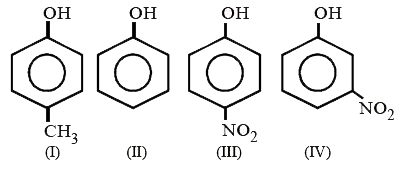In phenols
The ortho , meta and para position all are activated
The ortho and para positions are activated while the meta position is deactivated
The ortho and para position are more activated than the meta position
The ortho , meta and para position are equally acitivated
The correct Answer is:A, C
To answer the question regarding the activation and deactivation of positions in phenols, we can break down the explanation into clear steps:
1. Understanding Phenols:
- Phenols are organic compounds that contain a hydroxyl (-OH) group attached to an aromatic hydrocarbon ring. The simplest example is phenol itself (C6H5OH).
2. Identifying Positions on the Benzene Ring:
- In a phenolic compound, the benzene ring has six carbon atoms, and the positions relative to the hydroxyl group can be categorized as ortho (adjacent), meta (one carbon apart), and para (opposite).
3. Effect of the Hydroxyl Group:
- The hydroxyl group is an electron-donating group due to its ability to participate in resonance. This affects the reactivity of the aromatic ring in electrophilic aromatic substitution reactions.
4. Activation of Ortho and Para Positions:
- The ortho and para positions are activated because the electron-donating effect of the -OH group increases the electron density at these positions, making them more reactive towards electrophiles.
5. Deactivation of the Meta Position:
- In contrast, the meta position is deactivated because the electron density is not significantly increased at this position. The -OH group does not stabilize the positive charge that would develop during the formation of the sigma complex at the meta position.
6. Comparative Reactivity:
- Both ortho and para positions are equally activated and are more reactive than the meta position. This means that in reactions involving electrophiles, ortho and para substitution will occur preferentially over meta substitution.
Final Summary:
In summary, in phenols, the ortho and para positions are activated due to the electron-donating effect of the hydroxyl group, while the meta position is deactivated. The ortho and para positions are equally activated and are more reactive than the meta position.
---
- Phenols are organic compounds that contain a hydroxyl (-OH) group attached to an aromatic hydrocarbon ring. The simplest example is phenol itself (C6H5OH).
- In a phenolic compound, the benzene ring has six carbon atoms, and the positions relative to the hydroxyl group can be categorized as ortho (adjacent), meta (one carbon apart), and para (opposite).
- The hydroxyl group is an electron-donating group due to its ability to participate in resonance. This affects the reactivity of the aromatic ring in electrophilic aromatic substitution reactions.
- The ortho and para positions are activated because the electron-donating effect of the -OH group increases the electron density at these positions, making them more reactive towards electrophiles.
- In contrast, the meta position is deactivated because the electron density is not significantly increased at this position. The -OH group does not stabilize the positive charge that would develop during the formation of the sigma complex at the meta position.
- Both ortho and para positions are equally activated and are more reactive than the meta position. This means that in reactions involving electrophiles, ortho and para substitution will occur preferentially over meta substitution.
In summary, in phenols, the ortho and para positions are activated due to the electron-donating effect of the hydroxyl group, while the meta position is deactivated. The ortho and para positions are equally activated and are more reactive than the meta position.
Topper's Solved these Questions
- ALCOHOL, PHENOL AND ETHERBook:ERRORLESS Chapter:ALCOHOL, PHENOL AND ETHERExercise:JEE SECTION (Reasoning type questions)
Explore 3 Videos
- ALCOHOL, PHENOL AND ETHERBook:ERRORLESS Chapter:ALCOHOL, PHENOL AND ETHERExercise:JEE SECTION (Comprehension type questions) Passage-I
Explore 3 Videos
- ALCOHOL, PHENOL AND ETHERBook:ERRORLESS Chapter:ALCOHOL, PHENOL AND ETHERExercise:JEE SECTION (Only One Choice Correct Answer)
Explore 41 Videos
- ALDEHYDES AND KETONES Book:ERRORLESS Chapter:ALDEHYDES AND KETONES Exercise:JEE Section (JEE (Advanced) 2018) Numeric answer type question
Explore 1 Video
Similar Questions
Knowledge Check
Consider the following phenols :

The decreasing order of acidity of the above phenols isAIII gt IV gt II gt IBII gt I gt IV gt IIICI gt IV gt II gt IIIDIII gt IV gt I gt IIAt which of the following reaction condition phenol gives O-phenol sulphonic acid ?
AConc. H2SO4 at high pressureBDil. H2SO4 at low temperatureCConc. H2SO4 at low temperatureDDil. H2SO4 at high temperatureThe hybrid state of carbon, to which phenolic group is attached in phenol is
AspBsp2Csp3Ddsp2
p-nitro phenol is stronger acid than phenol. Explain.
View SolutionThe ionization constant of phenol is 1.0×10−10. What is the concentration of phenolate ion in 0.05M solution of phenol? What will be its degree of ionization if the solution is also 0.01M in sodium phenolate?
View SolutionUnlike phenols, alcohols are easily protonated. Or Alcohols are easily protonated in comparison to phenols. Or Why do phenols not give protonation reactions readily?
View SolutionWhen phenol is treated with concentrated nitric acid gives
4- Nitro phenol
2,4,6 -tri nitro phenol
Both
None
View SolutionAssertion : Ortho nitro phenol is more acidic than meta nitro phenol
Reason : Ortho nitro phenol has more –I effect than meta nitro phenol
View Solution

